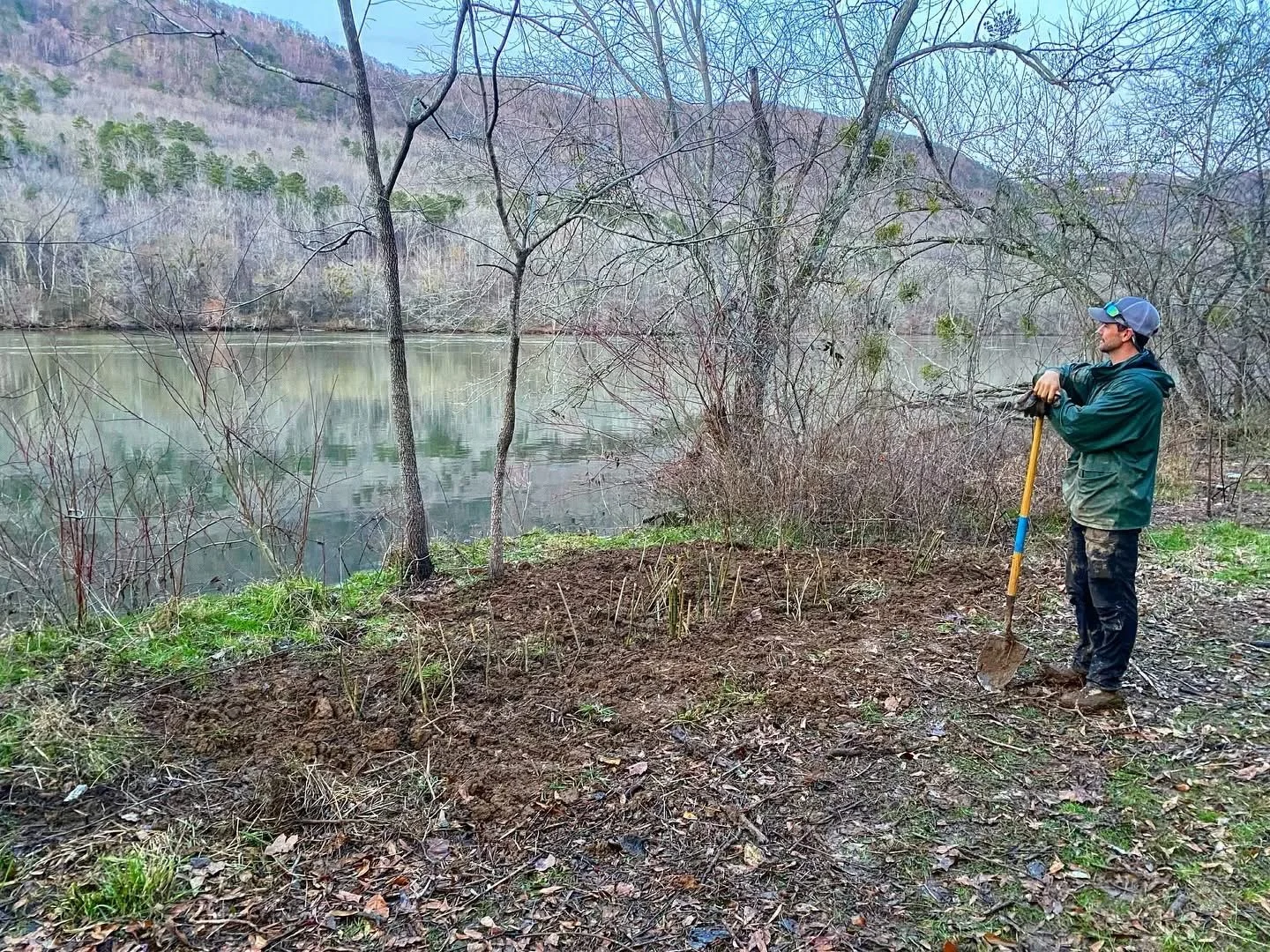Restoring Rivercane: Reviving a Cultural and Ecological Keystone
By Austin Young
As I admire the newly transplanted rivercane at the Tennessee River Gorge Trust’s Mike Linger Butterfly Meadow, I’m struck by the resilience of this native bamboo. The species persists in small pockets throughout the gorge in the face of constant and intense competition from other plant species that can outcompete the rivercane. The species is reported to have no good relationships with other plant species, thus, it fights its own battles for the survival of the fittest. The battle for continued existence constantly takes place in the wild and rugged Tennessee River Gorge.
In partnership with the City of Chattanooga, TRGT staff loaded up chunks of soil from a construction site in Hamilton County that contained rivercane. It was mid-February and a rainstorm was predicted to hit the following morning. The crew found an ideal location beside the Tennessee River, which was pointed out by botanist Zach Irick from Southeastern Grasslands Institute. They worked the soil and plopped the big, wet chunks of soil into the ground. After a couple of months….boo ya! Bright green rivercane stalks were visible in throughout the transplanted area. By late June, some stalks were approaching 4 feet tall.
Rivercane that has, so far, been successfully transplanted from a construction site in Hamilton County to our Mike Linger Butterfly Meadow. The Meadow exists along River Canyon Road near the historic Pot Point Cabin.
Rivercane (Arundinaria gigantea), often called giant cane, is more than just a plant—it’s a living link to the cultural and ecological heritage of the southeastern United States. For centuries, it has shaped landscapes and sustained communities, yet today it teeters on the edge of obscurity, reduced to a fraction of its former abundance. Former “canebreaks,” a term reserved for large patches or thickets of the species, are much diminished in size and extent from the pre-European settlement days. As someone working with a conservation organization, I’ve seen firsthand the urgent need to restore this remarkable species as it fights to thrive in a changing world. In this blog, I’ll share the natural history of rivercane, its precarious conservation status, and why its restoration is critical for both ecosystems and cultural traditions.
The Natural History of Rivercane
Rivercane is one of three native bamboo species in the United States, all belonging to the genus Arundinaria. Unlike the invasive Asian bamboo species often mistaken for it, rivercane is a woody grass endemic to the south-central and southeastern U.S., historically stretching from New York to Florida and as far west as Ohio and Texas.
A 2014 map showing the counties that comprise Rivercane populations. The dark green outlines the boundary of the U.S. state while the bright green shows the county where Rivercane is known to exist.
It thrives in fertile river valleys, floodplains, and wetlands, forming dense thickets known as canebrakes that once covered an estimated 10 million acres across the southeast. These canebrakes were iconic, described by early explorers as vast, almost impenetrable stands that could stretch for miles along riverbanks. Think of explorers as early to mid-1700’s folks like John Lawson, William Bartram, William Byrd, and Mark Catesby.
An old photo of a person on a horse in front of a canebreak. Source unknown.
Rivercane grows from an extensive network of underground rhizomes, sending up hollow, rounded stems that can reach heights of 33 feet and diameters of 3 inches. This species rarely flowers or fruits, usually just before death, which might be after several decades. Many biologists have likely never seen this species in flower or fruit. Botanist Alan Weakly gives an average of fruiting every 40-50 years. Its lance-shaped leaves and robust root system make it a powerhouse for stabilizing soil and filtering water. Canebrakes are fire-dependent ecosystems, historically maintained by Indigenous practices like prescribed burns, which prevented forests from encroaching and encouraged vigorous regrowth. In fact, early explorer John Lawson reports Creek Indian farmers using Rivercane as a fencing! Rivercane’s ability to resprout quickly after fire or harvesting underscores its adaptability, a general trait that has allowed it to persist despite centuries of challenges, including the suppression of wildfire and other forms of ecological disturbance.
Ecologically, rivercane is a keystone species, meaning it plays a disproportionately large role in its environment. Canebrakes provide critical habitat for wildlife, including species in need of management like the Swainson’s Warbler (Limnothlypis swainsoni) and possibly the extinct Bachman’s Warbler (Vermivora bachmanii), which used rivercane for nesting. They act as natural fire breaks, filter pollutants from water, and stabilize stream banks against erosion. Its dense rhizomes also enhance soil quality, making it a vital component of healthy riparian ecosystems. For wildlife, rivercane offers cover, forage, and even denning sites for species like the black bear (Ursus americanus). By the way, at the TRGT Bird Observatory, we have documented common use of Rivercane thickets by migrating and resident passerines.
Culturally, rivercane is equally significant. For thousands of years, Indigenous nations across the Southeast, including the Cherokee, Choctaw, Creek, and Chitimacha, have revered it as a cultural keystone species. They used it for everything from basket weaving and blowguns to ceremonial items and construction materials. The plant’s versatility made it useful in daily life, and its harvesting required intimate knowledge of its ecology—when to cut, how to select the right stems, and how to manage canebrakes sustainably.
Baskets (top and bottom left) and flutes (right) were a common use for Rivercane for Indigenous cultures. Heart of Louisiana photo. Country Roads Magazine photo.
Cobb Cave rivercane basket with woven repeated flipped and mirrored triangle design (UA Museum accession no. 68-733-8). ARAS photo and inset drawing by Elizabeth Horton.
The Conservation Status of Rivercane
Today, rivercane once occupied nearly a third of the southeastern U.S. but is a shadow of its former self. It’s estimated that only 2% of its historic range remains, making canebrakes one of the most threatened ecosystems in the Southeast. This drastic decline stems from multiple factors, including temporarily ceased traditional stewardship practices like controlled burns, which were important for maintaining healthy canebrakes. Subsequent land conversion for agriculture, overgrazing by livestock, wildfire suppression, and urban development further diminished rivercane populations. The introduction of invasive species, like Chinese privet (Ligustrum sinense) and Asian bamboo species, has also crowded out native cane, which can struggle to compete without active management.
The ecological fallout from this loss is quite profound. Without canebrakes, riverbanks erode more easily, water quality suffers, and wildlife lose critical habitat. Culturally, the scarcity of rivercane threatens Indigenous traditions. Artisans, like Cherokee basket weavers, must travel long distances to find harvestable cane, and the knowledge of sustainable harvesting risks fading as access to healthy stands dwindles. The Cherokee Nation has listed rivercane as a Culturally Protected Species, underscoring its importance and the urgent need for conservation.
Rivercane’s conservation status isn’t formally listed under federal frameworks like the Endangered Species Act, but its rarity and ecological significance have prompted action from organizations like the Rivercane Restoration Alliance (RRA), a partnership between Tribal nations, federal agencies, and researchers. The RRA and similar initiatives, such as the River Cane Initiative in Oklahoma, are mapping existing canebrakes, studying propagation methods, and promoting restoration projects. These efforts highlight the plant’s vulnerability and the need for collaborative action to reverse its decline.
The Need for Restoration
Restoring Rivercane isn’t just about bringing back a plant—it’s about reviving ecosystems and cultural heritage. My own experience transplanting Rivercane on TRGT property has shown me how feasible restoration can be with the right approach. Rivercane propagates relatively easily through rhizome cuttings or transplanting chunks of intact soil, and it responds well to management practices like prescribed burns and the removal of competing species. By restoring canebrakes, we can rebuild the ecological services they provide: stabilizing riverbanks, improving water quality, and supporting biodiversity. These benefits extend beyond wildlife to human communities, as healthier watersheds mean cleaner water and reduced flooding risks.
Citizen science initiatives, such as reporting rivercane sightings on apps like iNaturalist, can help map remnant patches and guide restoration efforts. Landowners can play a role by planting and managing rivercane.
The tall, thin rivercane in the same location as the previous photo but later in the spring. Success!
The author admiring the view after transplanting a patch of Rivercane from an urban construction site into a wild and rugged gorge.
A Call to Action
A photo of a mature canebreak. Our State Magazine photo.
Restoring rivercane is a collective effort that starts with understanding its value. On our property, I’ve seen how a small patch of rivercane can have the potential to transform a landscape, creating a haven for wildlife and a reminder of the Southeast’s rich history. But scaling up these efforts requires broader support. You can help by learning to identify rivercane, supporting conservation organizations, or even planting it on your own land if you live in its native range. If you know of a canebrake, report it to local databases like iNaturalist, local conservation groups, or Tribal nations working to protect it, like the Choctaw Nation’s Rivercane Initiative based in northeastern Oklahoma.
Magnolia Warbler is one of many species of birds known to use Rivercane during migration! We captured this individual foraging in a patch of Rivercane during fall migration mist netting surveys.
The story of rivercane is one of resilience, but it’s also a call to action. By restoring this cultural and ecological keystone, we can restore important ecosystems, honor the people that have used it for generations, and ensure the future outdoor recreationists can weave baskets, hunt in healthy canebrakes, or simply marvel at the beauty of a native plant that has shaped the Southeast for millennia. Let’s work together to bring rivercane back—not just for the land, but for the stories, traditions, and wildlife it sustains!












